The 2005 relaunch of Doctor Who on television made the show as big a deal in the colonies as it is back home in the UK. But, in truth, The Doctor made his first appearance on American shores decades earlier…
…sorta. Your Major Spoilers (Retro) Review of Dr. Who And The Daleks (aka Dell Movie Classics) 12-190-612 awaits!
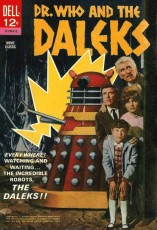 DR. WHO AND THE DALEKS 12-180-612
DR. WHO AND THE DALEKS 12-180-612
Writer: Milton Subotsky/Terry Nation (original film script)
Penciler: Dick Giordano
Inker: Sal Trapani
Letterer: Uncredited
Editor: Don Arneson
Publisher: Dell Comics
Cover Price: 12 Cents
Current Near-Mint Pricing: $160.00
Previously in Dr. Who And The Daleks: So, I suppose you’re wondering why in the heck a one-shot comic, which would traditionally have either no number or a #1, has such an odd number. Welcome, Faithful Spoilerites to the world of Dell Comics! The extremely confusing numbering scheme used by Dell throughout most of the 60s into 1971 works as follows: the first two digits are generally the price (except with certain Dell Giants), the 180 indicates that the title starts with a D, for some reason, while the 612 is a date indicator (“6” for the year, 1966, and 12 for December.) Your guess is as good as mine as to how successful this scheme was, but it should be noted that the change in numbering coincides with the decline of Dell Comics, which ceased publishing entirely in 1973.
As for the Time Lord known as The Doctor, those not in the know are probably in for a surprise or two opening this particular comic book issue…
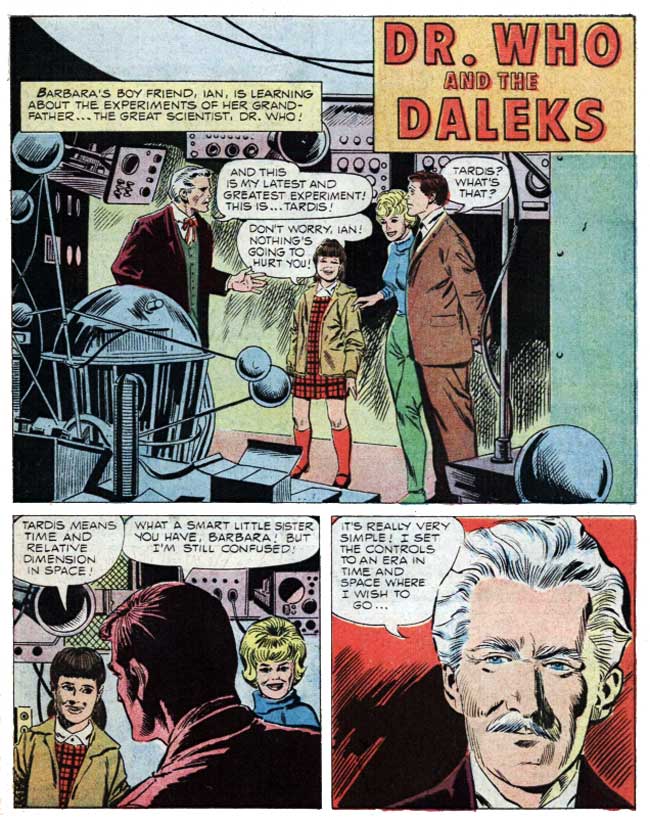
The First Rule Of Dell Movie Classics Club: Context is for suckers. Given that they’re adapting 83 minutes of film into 40 pages of comic book, you almost can’t blame them, especially since these types of comic books were designed as keepsakes for those who actually saw the movie in theaters the previous year. With home viewing/reviewing options so rare as to be nonexistent in those days, Dell’s Movie Classics and their ilk allowed kids to relive favorite stories that they might never get to see again. Fans of the First Doctor’s adventures will also notice a few changes from the source material, such as Susan being de-aged, The Doctor growing a moustache (and also growing a foot taller) but most of all, designated hero Ian being something of a useless klutz…
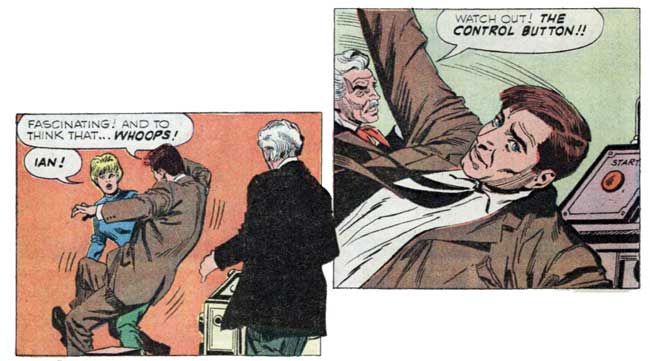
When Amicus Productions optioned the rights to the BBC’s ‘Doctor Who’ programme (that final e is important, for some reason) for the big screen, the show was in its infancy, and so the producers made whatever changes they felt like making to create a 2-hour movie designed to appeal to younger audiences. Dr. Who, it seems, it actually NAMED Who, and both the female characters are his granddaughters here, as opposed to just Susan in the television show. (I honestly don’t recall if the television version of the character had been revealed to actually be an alien yet, but I believe so.) Thanks to Ian’s bumbling, TARDIS (they don’t use the definite article in the film or this book) is sent on a jaunt through space and time, with no idea where. Venturing out of the capsule, the group finds itself in a strange petrified jungle, with no sign of life…
…until a hand swipes at Susan from the darkness!
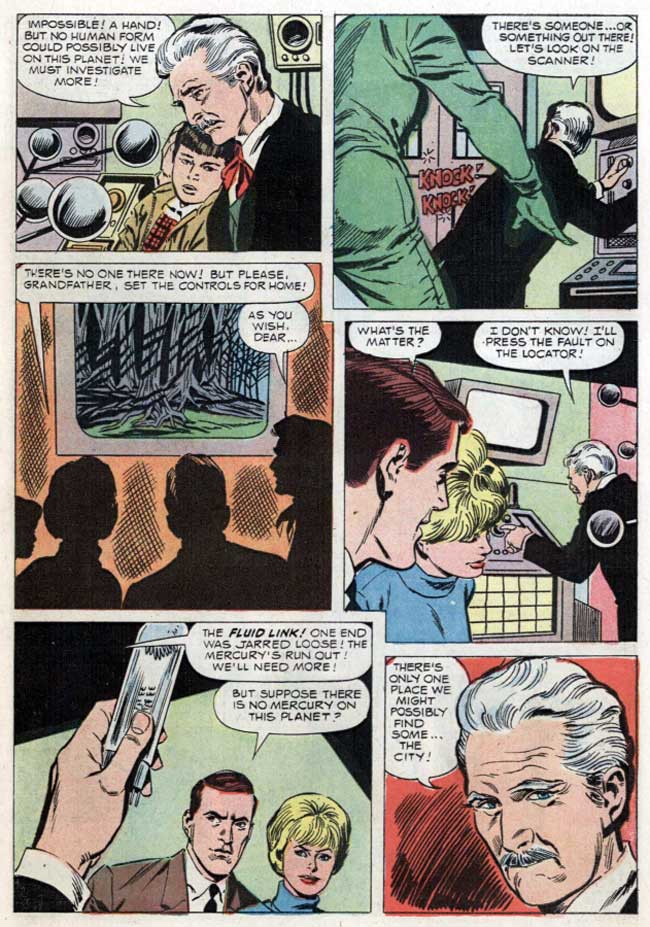
With TARDIS lacking vital fluids to function, Dr. Who and his companions have no choice but to set out for the nearby city, seemingly the only one on the devastated planet. They begin scouring the city, but are separated, with Barbara panicking and running away, while Dr. Who discovers that the radiation levels on this world are dangerously elevated. Why, it’s the kinda thing that could mutate humanoids into hideous, freakish mutants…
(Cue Daleks!)
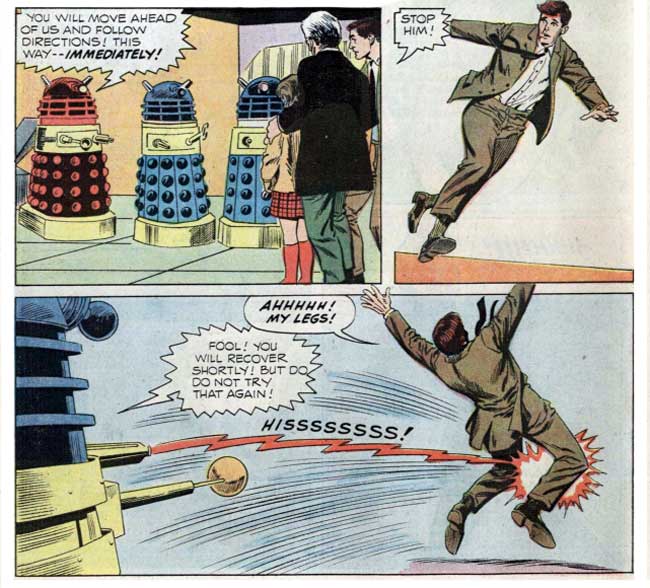
Dr. Who proves to have a few things in common with his alternate-universe alien counterpart, when he reveals that the mercury ploy was a ruse, a ploy that would allow him to examine the strange city, despite his companions fears, putting them all in mortal danger to assuage his own curiosity. Fortunately for Ian, the Dalek’s frap-guns seem to have a stun-setting in this world; just one of a number of variances, as the movie Daleks are also larger than Season 1 TV Daleks, and several of them are equipped with claw appendages in place of toilet plungers…
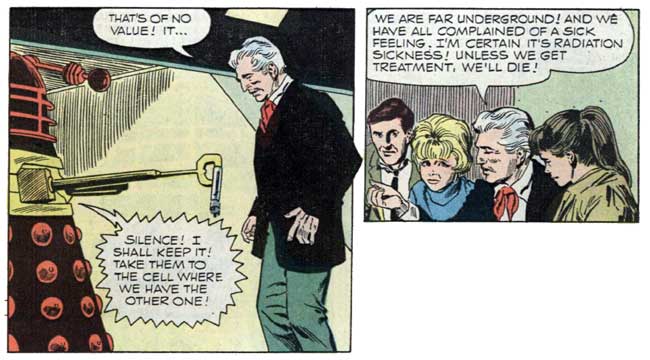
Sadly, thought the mercury trick was nothing but a ploy, having the Daleks steal the entire fluid link means that they’re officially stranded in their clutches. Remembering a crate of strange chemicals they encountered early, Dr. Who theorizes that it must have been an anti-radiation serum, one that could protect humans in the terrible post-atomic mess of Skaro’s atmosphere. (I’m extrapolating a bit, as the planet is never named here, but the second Dr. Who/Dalek flick uses the television name.) For reasons unclear, The Daleks begin explaining to their prisoners the history of their planet, a history predicated on a struggle for control against their ancient enemies, the Thals…
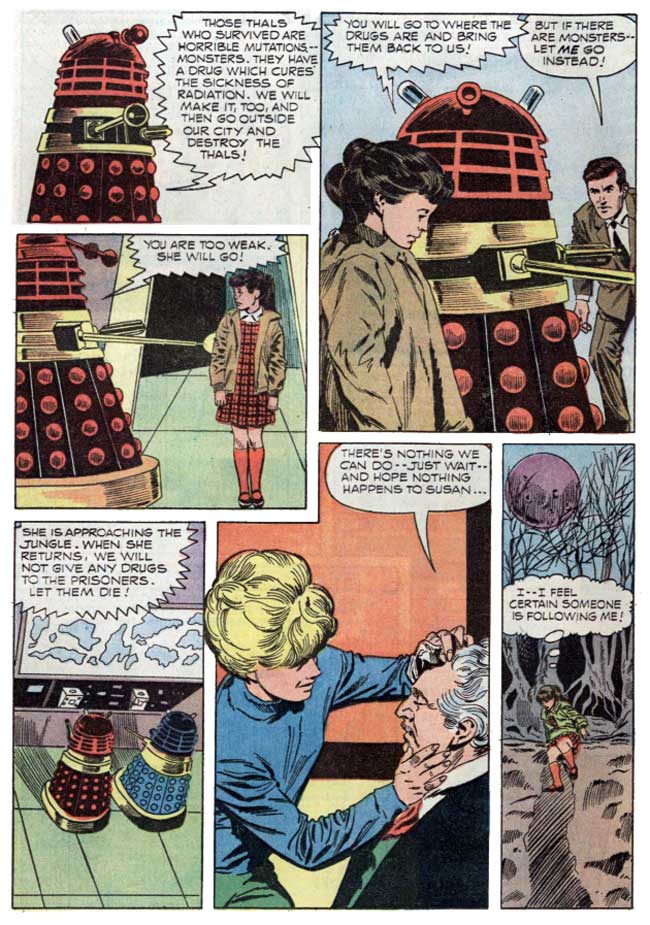
Sharp-eyed Whovians may be wondering about the colorful Daleks seen in these pages, and whether it’s just a concession to the four-color printing practices of the 60s: It is not. ‘Dr. Who And The Daleks’ is the first appearance of the Daleks and other concepts of ‘Doctor Who’ in full-color, as the first seasons of the show were created in black-and-white. Indeed, several of the design elements originated here migrated to Who-canon, as the movie-created Daleks were rented to appear on TV, with the episode featuring them actually airing BEFORE the film came out.
Aaaaaanywaaaay, young Barbara, sent to retrieve the anti-radiation drug, is once again sure she’s being followed, and encounters a friendly Thal on her way back to the (strangely hunter-green) time travel device. The Thal helps her to smuggle in TWO doses of anti-rad meds, which saves her grandfather and sister, but also gives the Daleks what they need to amass an attack on the Thals…
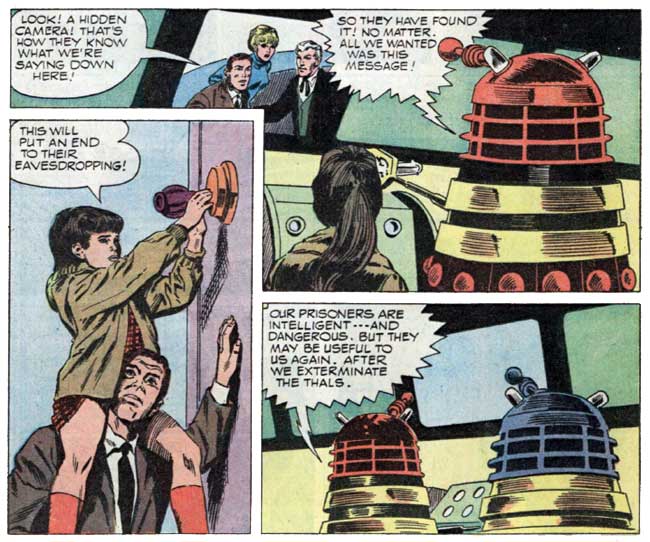
Using Susan’s friendship as a ploy, the Dalek’s try to lure the Thals in with food, leading the unusually trusting people to believe that their long war is over. With the Thals in mortal danger, Dr. Who proves himself to be on a par with his alien counterpart in the old “Indy Ploy,” devising an escape place using the empty serum box, a cloak the Thal gave Susan, and the mud on their shoes…
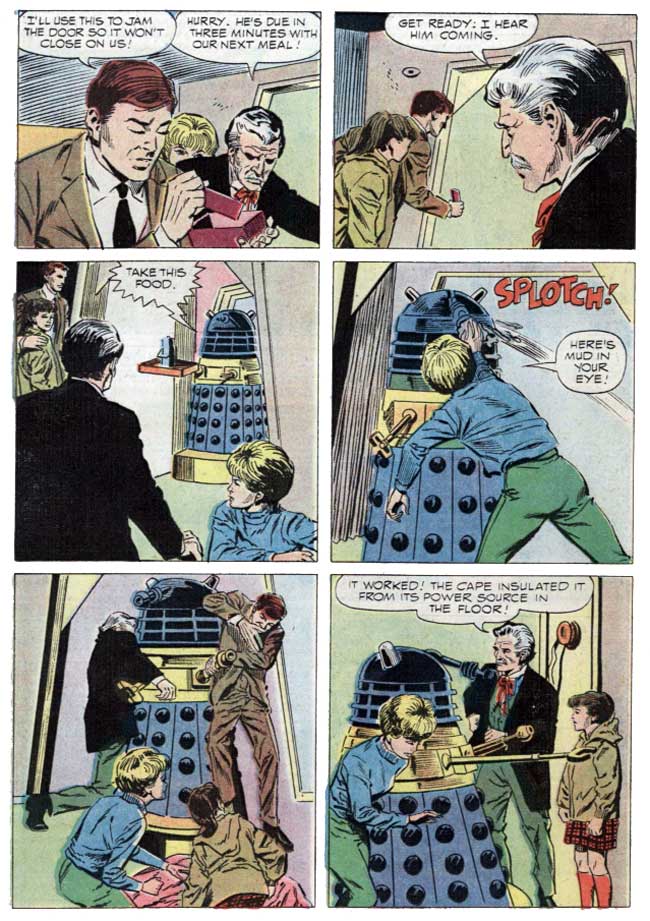
Commandeering the Dalek, Ian gets inside (!!) and pretend to escort his friends out of the base. Several tense reversals (all of which get adapted into maybe ten panels of Dick Giordano art) later, Dr. Who arrives just in time to warn the Thals about the Dalek treachery, allowing the aliens to make a run for it…

Who throws his lot in with the Thals, helping to craft a plan that will allow a small party to infiltrate the Dalek’s base and stop the renewed Dalek/Thal war before it ever starts. Using his science knowledge and his companions courage, as well as the Thals’ resourcefulness, our heroes overcome the Dalek’s perfidy, but have to return to save the captured Dr. Who and Susan!
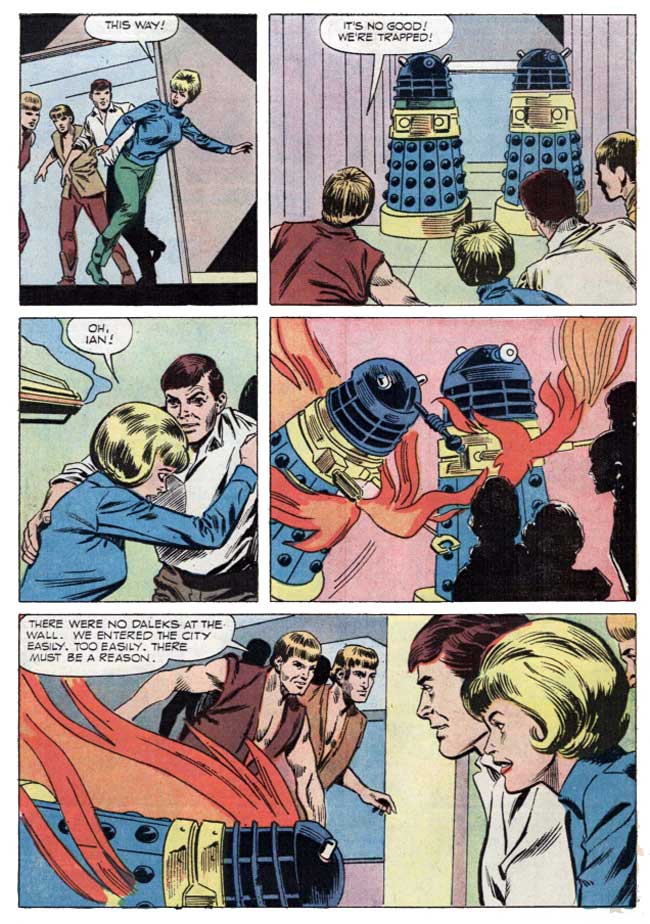
Retrieving the fluid link, Dr. Who tricks a Dalek into shooting the main control console, the explosion of which destroyed the main power source that transmits energy to the Daleks, thus entirely destroying (this particular next of) the monsters! Thanking their new Thal friends, Dr. Who and his team repair TARDIS, and take off in their once-again-green ship…
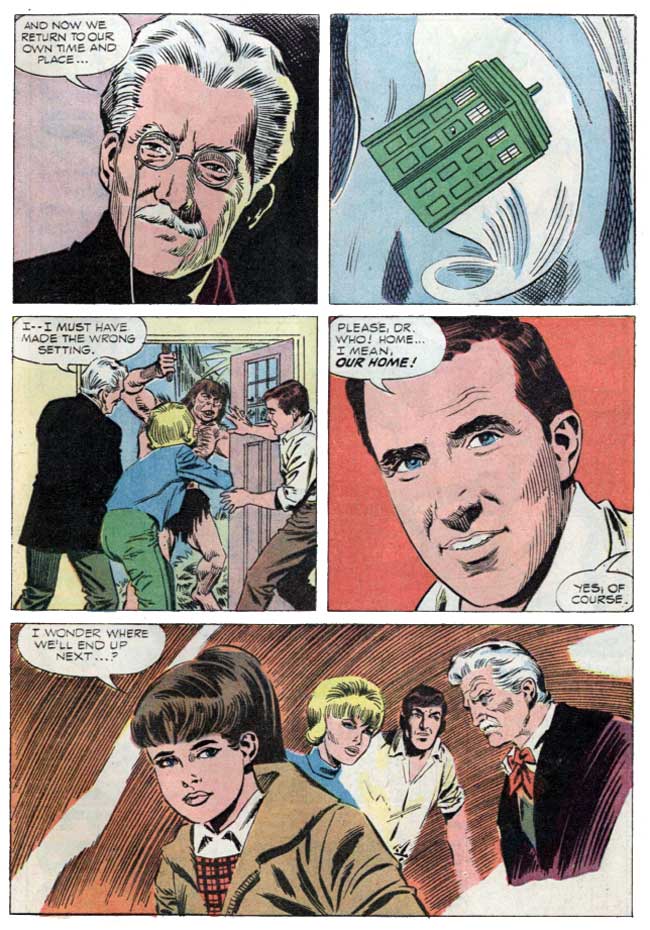
…40 years later, we’re still wondering. Though a sequel film was made, Dell didn’t adapt it for comics, leaving the comic book version of the movie version of the TV series that has become an institution forever in limbo. As with any movie adaptation of the period, much of the story is condensed, reworked and hammered into shape, making this book a pretty confusing read (though, to Dell creators’ credit, the film being adapted is a weird, occasionally dry affair with some strange pacing, anyway.) Statistically speaking, though, there HAVE to be at least a few Who-fans in the world whose very first Doctor story was this comic book adaptation, leading them into a life of time-travel nerdery, so that’s kinda neat…
The main draw here, other than the “Whut th…” aspects of this alternate world of Dr. Who is in the art of Dick Giordano, already 15 years into a stellar career as artist, writer and editor. In short, while Dr. Who And the Daleks 12-190-612 makes for fascinating study about adaptations, publishing processes of decades past and the fifth-dimensional numbering of sixties Dell Comics, it’s only kind of okay as a comic book reading experience, leaving it with 2 out of 5 stars overall. It is, however, exemplary of Dell Comics cavalcade of comics, where the goal was to get as many books out (some reports claim that Dell sold more than 20 million comics PER MONTH in the heady days of the Golden Age) and into the hands of kids as possible.
[taq_review]



2 Comments
I have to say the artwork isn’t too off from what the movie looks like (outside of course some coloration which isn’t that unusual and a change to the ending, which I won’t spoil). I have to say, even as a who fan, I do sort of have a soft spot for the first of the two dalek films (second one just wasn’t as good) and it at least had some creative design choices to it. It is pretty interesting seeing this comic book take on that film.
oh and it’s been pretty much confirmed that Susan is a Time Lord.
Very interesting article about two things I have never heard of: the Doctor Who movie and this comic. I may have to try and find this to read it. I love the art from the time period so it loos like something I would have picked up if I had been alive and could have fount it.